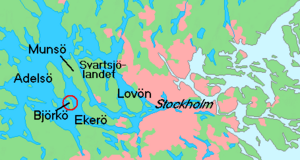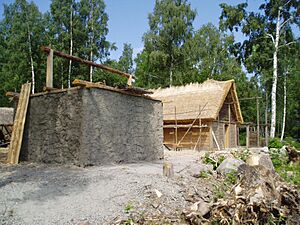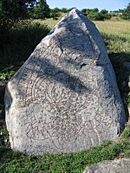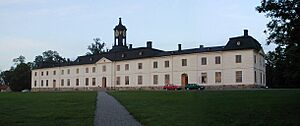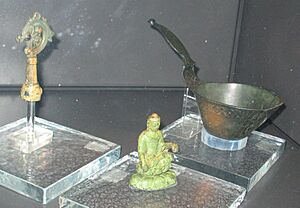Ekerö Municipality facts for kids
Quick facts for kids
Ekerö Municipality
Ekerö kommun
|
||
|---|---|---|
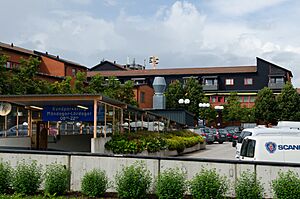 |
||
|
||
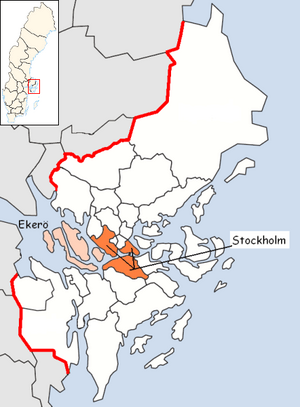 |
||
| Country | Sweden | |
| County | Stockholm County | |
| Seat | Ekerö | |
| Area | ||
| • Total | 386.58 km2 (149.26 sq mi) | |
| • Land | 216.39 km2 (83.55 sq mi) | |
| • Water | 170.19 km2 (65.71 sq mi) | |
| Area as of January 1, 2010. | ||
| Population
(June 30, 2012)
|
||
| • Total | 25,201 | |
| • Density | 65.1896/km2 (168.840/sq mi) | |
| Time zone | UTC+1 (CET) | |
| • Summer (DST) | UTC+2 (CEST) | |
| ISO 3166 code | SE | |
| Province | Uppland | |
| Municipal code | 0125 | |
| Website | www.ekero.se | |
| Density is calculated using land area only. | ||
Ekerö Municipality (which means Ekerö kommun in Swedish) is a special area in Sweden. It is like a local government district. It is located in the Uppland province, which is part of Stockholm County in central Sweden. The name "Ekerö" comes from the main island in the area, Ekerön. It means "Oak Island." The main town, or "seat," of the municipality is also called Ekerö.
Did you know that the King of Sweden lives in Ekerö Municipality? His home is Drottningholm Palace, which you can read more about below.
Ekerö Municipality was formed over time. In 1863, there were eight small local areas. These areas joined together in 1952 to form two bigger ones. Then, in 1971, these two larger areas combined to create the Ekerö Municipality we know today.
Contents
Exploring Ekerö's Geography
Ekerö is unique because it is the only municipality in the Lake Mälaren area that is made up only of islands. Over many years, the land has slowly risen. This has reduced the number of islands and small rocky islands (skerries) to about 140. The biggest islands are Adelsö, Munsö, Ekerö, Färingsö, and Lovö. Long ago, about 2000 years ago, Färingsön was actually a group of twenty smaller islands.
Historical Treasures of Ekerö
Ekerö Municipality is home to two amazing places recognized by UNESCO as World Heritage Sites. These are very important places that are protected for everyone to enjoy. One is Birka, an ancient Viking Age village. The other is Drottningholm Palace and the beautiful area around it.
Drottningholm Palace is on the island of Lovö. It was first built as a Renaissance palace by King John III for Queen Catherine Jagellon. Sadly, the old palace burned down in 1661. But Queen Dowager Hedvig Eleonora had a new palace built. It used the old walls and cellars and was designed in the French Baroque style.
Since 1981, Drottningholm Palace has been the home of the royal family. Even though it's a royal home, many parts of the park are open for visitors. The palace has special features, like the Palace Theatre. This theatre opened in 1766 and still puts on operas using its original old machinery! There is also the Chinese Pavilion. This building has a Rococo design and is filled with beautiful Chinese items. These items were brought to Sweden by the Swedish East India Company.
Birka is on the island of Björkö. It is the oldest town-like place in Sweden. It was started in the mid-8th century, during the Viking Age. In the 9th century, a missionary named Ansgar tried twice to teach the people about Christianity, but he was not successful. The town was left empty in the late 10th century, and no one knows exactly why.
People started digging up the area in 1871. They have found about 1,100 graves. A museum was opened in 1995. In the summer, many boats take tourists to the island to explore this ancient site.
Other Interesting Historical Places
Ekerö has many other cool historical spots. You can find several runestones and other things left behind by the Vikings. There are also eight medieval churches and old towns to explore.
On the island of Adelsö, you'll find Hovgården. This place is also a World Heritage Site, just like Birka. It has old burial mounds, strong walls, and runestones. Another site is Alsnö hus, which are the ruins of a summer home. Here, the Ordinance of Alsnö was created, which helped start the Swedish nobility. There's also a Romanesque church from the 12th century.
Right next to the royal palace is a living area called Drottningholmsmalmen. This area has a long history, going back to a manor built in 1579. It was a safe place for Jesuits after the Reformation. In the 18th century, soldiers and craftspeople who worked at the Royal Palace started living here. The idea was to make it a suburb for the palace, like at the Versailles Palace in France. King Gustav III built several buildings, including the Långa raden ("Long Row"), for the royal guards. By 1815, there were 78 properties. However, it didn't become a big city. Instead, it became a summer home area for rich people. The large, unique villas give the area its special look. In the mid-20th century, famous Swedish architects added more buildings.
Kanton is a group of twenty buildings near the Chinese Pavilion. They were built in the 1750s and 1760s. It was meant to be a test village for trade. About 70-80 people lived there for a few decades. They made fancy items for the royal court and rich families, including some of the decorations inside the China Pavilion. These buildings later inspired the author Elsa Beskow to write some of her famous fairy tales.
Kungshatt ("King's Hat") is a rocky island south of Lovön. A legend says that a king named Erik Väderhatt ("Eric Weather Hat") escaped his enemies here. He was called "Weather Hat" because he could predict the winds with his hat. The legend says he jumped from the cliff with his horse. A copper hat was placed there to mark the spot, but now it's an iron hat.
Svartsjö Palace was once a large house belonging to the Folkung family. The palace built by King Gustav I and his sons was destroyed by fire in 1687. The current rococo palace was built between 1735 and 1739. It was designed by Carl Hårleman and later made bigger by Queen Louisa Ulrika. For many years, it was not cared for, but it has now been restored. Its Baroque and English gardens are still beautiful.
Hilleshög Church is an old church, mostly built in the Romanesque style. It is made of granite and brick. Some parts were added in the 17th and 18th centuries. Many of the paintings inside the church are from the late 13th and early 15th centuries. They were painted over in the 18th century but were uncovered and restored in the 1920s and again in 2002.
Ekebyhov is a large property that started around 1630. Its main building, Ekebyhov Palace, is made of wood. It was started in 1674 and finished in 1704. It is the oldest wooden palace still standing in Europe! The palace gardens have many unique plants and a café. The municipality has owned it since 1980.
Skytteholm is a historic farm. Its main building, Skytteholm Mansion, was one of the large homes built by Johan Skytte. He was a teacher to Gustavus Adolphus the Great. The mansion was founded in 1631, but it looks mostly as it did around 1920. Today, it is mainly used for conferences and as a hotel.
In the 1950s, very old remains were found on the island of Helgö. Digging there uncovered eight groups of buildings and objects from faraway places like Ireland, Egypt, and India. These items date back to the 8th century. They show how much trade happened back then! People believe the settlement is much older and was busiest around 500-600 CE. On Helgö, you can also find Kaggeholm Palace, which has a history going back to 1370. The palace itself was built in the 1720s.
The Barrow of Björn Ironside on Munsö Island is part of an Iron Age burial ground. On Munsö, you can also see Munsö Church. It is one of only three round churches in the Stockholm area. It was probably built in 1187 and has several old wooden sculptures inside.
Enjoying Ekerö's Nature
Ekerö is a great place for outdoor fun! You can go fishing or bicycling, as nature is always close by. Each island also offers its own special experiences and sights to see.
Ekerö's Population Over Time
Population Development
| Year | Population |
|---|---|
| 1970 |
12,594
|
| 1975 |
15,081
|
| 1980 |
15,927
|
| 1985 |
16,534
|
| 1990 |
18,785
|
| 1995 |
20,866
|
| 2000 |
22,266
|
| 2005 |
24,010
|
| 2010 |
25,410
|
| 2015 |
26,984
|
| 2017 |
27,753
|
| 2019 |
28,690
|
The population in Ekerö Municipality has grown steadily over the years. In 2019, there were 28,690 people living there.
Getting Around Ekerö
Public Transportation
Ekerö has a good public transport system run by SL. All the bus routes connect to the Stockholm metro at Brommaplan. Recently, a ferry service also started, running regularly between Ekerö and Stockholm city.
Roads and Ferries
County road 261 connects drivers from Brommaplan and other western parts of Stockholm to Ekerö. There is only one bridge, Nockebybron, that connects the municipality to the mainland. But there is also a car ferry that can take drivers to Botkyrka Municipality, which is southwest of Stockholm.
Ekerö's Sister Town
Ekerö is connected to another municipality as a "sister town." This means they share ideas and culture.
 Otepää, Estonia
Otepää, Estonia
Towns and Villages in Ekerö
Here are some of the towns and villages you can find in Ekerö Municipality:
- Bergvik
- Björndal
- Brygga
- Ekerö
- Drottningholm
- Jungfrusund
- Kungsberga
- Lurudden
- Parksidan
- Sluts brygga
- Solsidan
- Stav
- Stenhamra
- Sundby
- Svartsjö
- Tureholm
- Väsby
- Älvnäs
- Ölsta
See also
 In Spanish: Municipio de Ekerö para niños
In Spanish: Municipio de Ekerö para niños



